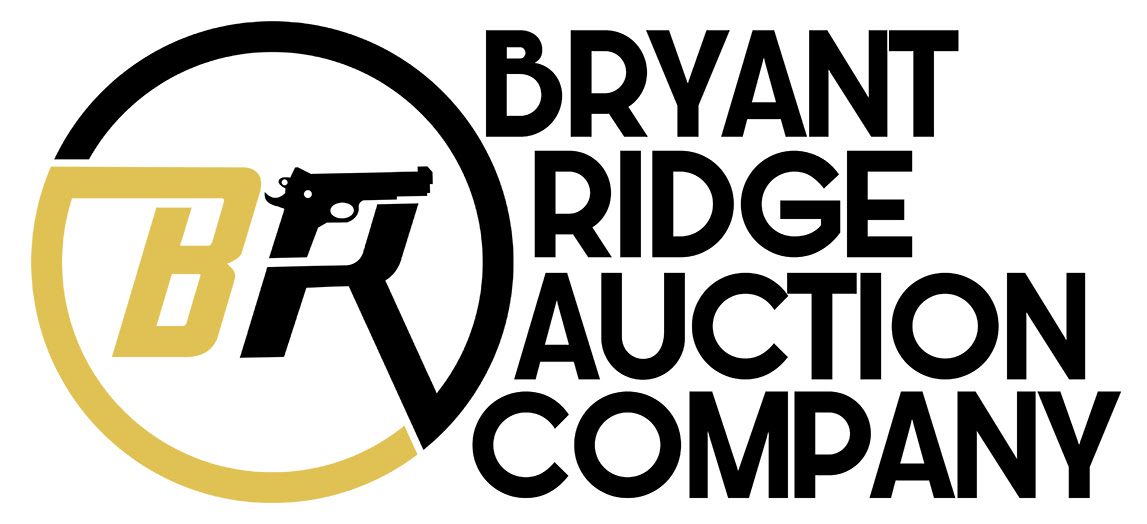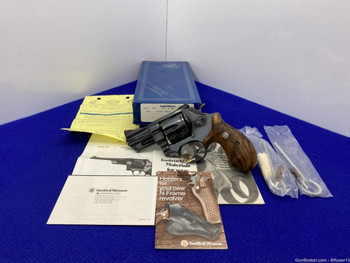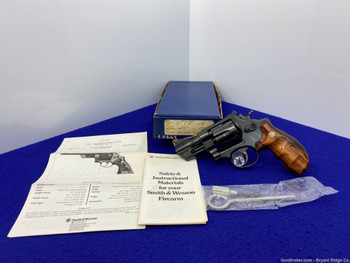Description

Item Description
Bryant Ridge Auction Company is thrilled to present this limited edition double-action revolver today for a penny-start auction; this is the Smith & Wesson 24-3, also known as the 1950 .44 Target Reintroduction! The 24 is the sister model to such classics as the 25, 27, and 29 models.
The Model 24-3, also known as the Lew Horton Combat Variation, was manufactured between 1984 and 1985 and had a product code 100787. This particular version was a special edition with a 3-inch barrel, a red ramp front sight, a micrometer adjustable rear sight with a white outline, and a blue finish. It's worth noting that this special edition was limited to only 5,000 units.
The Model 24-3, also known as the Lew Horton Combat Variation, was manufactured between 1984 and 1985 and had a product code 100787. This particular version was a special edition with a 3-inch barrel, a red ramp front sight, a micrometer adjustable rear sight with a white outline, and a blue finish. It's worth noting that this special edition was limited to only 5,000 units.
SPECIFICATIONS:
Manufacturer: Smith & Wesson
Model: 24-3 Lew Horton Exclusive
Serial: ALA4972
Date of Manufacture: 1985
Caliber: .44 S&W Special
Finish: Blue
Barrel Length: 3" Full Lug
Optics/Sights: Red Ramp Front & Micrometer Adjustable Rear with White Outline
Stock/Grips: Smooth Wooden Finger Groove with inlaid S&W Medallions
Action: Double/Single
Markings: Standard
Bryant Ridge's Analysis:
In 1905, Smith & Wesson enjoyed the success of its Hand Ejector Series of double-action revolvers featuring a swing-out cylinder. The company had spent 10 years perfecting these revolvers and had started manufacturing them in the I- (.32 cal.) and K- (.38 cal.) frames. Plans were underway for a new, larger .44-cal. frame and the first cartridge for this new frame would be an updated version of the .44 Russian round. To create the new cartridge, Smith & Wesson’s engineers lengthened the case by .360" and added 3 grains of black powder to a 246-gr. round-nose bullet, resulting in a muzzle velocity of 755 fps from a 6" barrel. The new cartridge was named the .44 Smith & Wesson Special, and the company's new revolver was called the .44 Hand Ejector First Model.
In the early days of producing the Hand Ejector Second Model, some customers requested that Smith & Wesson bring back the shrouded ejector rod. The company was initially hesitant as they felt it wasn't a popular feature the first time around and was also expensive to produce. However, a company in Fort Worth, Texas, called Wolf & Klar, placed an order for 3,500 Second Models with a shrouded extractor rod. Harold Wesson, who was leading the company co-founded by his grandfather in 1926, decided to produce the shrouded extractor rod. This led to the creation of the Hand Ejector Third Model, also known as the Model 1926. The Third Model was only available through special order and was not included in the catalog until after 1940. After the war, most of the Third Models were made using already available parts. Sales were weak, so the company decided to modernize its line.
The Hand Ejector Fourth Model, also known as the Model 1950 Target Model, was a revolver with several new features, including a rib at the top of the barrel, a short-action hammer, and an adjustable micrometer-style sight. However, it didn't sell well initially, with only 244 units sold in the first three years of its production. It had too much recoil for target shooters, and its 6.5-inch barrel was too heavy for most law enforcement officers. The Model 1950 was saved by Elmer Keith, who praised it for its ability to handle his heavy .44 field loads. Introducing the .44 Mag. in 1956 dealt another blow to the Model 1950. In 1957, Smith & Wesson adopted a new model numbering system, and the Model 1950 was renamed the Model 24. It remained in production until 1966, when it was discontinued.
In the 1970s, a gun writer from New Mexico, along with a few other like-minded individuals, started promoting the .44 Spl. cartridge and the Model 24 revolver. One of these enthusiasts was Skeeter Skelton. He realized the benefits of using a 4-inch revolver that could handle hand-loaded .44 Spl. cartridges were more accurate and easier to control than the .44 Mag. revolver. Smith & Wesson, like most gun manufacturers, may have been a bit slow to recognize a trend in the past. However, in 1983, it reintroduced the Model 24 with a limited run of 2,625 revolvers that had 4" barrels and 4,875 revolvers with 6 1/2 inch barrels. These models are known as the Model 24-3. Lew Horton, the Massachusetts distributor, commissioned a special run of Model 24s with 3" barrels and a K-frame-sized round butt.
Contents:
The owner states that this example remains New Old Stock and we see no evidence to indicate otherwise. Additionally, it will ship with the original box, paperwork, and the cleaning tools pictured above!
Return Policy:
We gladly offer a 3 day unfired inspection policy from the time that the firearm is delivered to your FFL. Refunds are available for all qualifying orders.
Model: 24-3 Lew Horton Exclusive
Serial: ALA4972
Date of Manufacture: 1985
Caliber: .44 S&W Special
Finish: Blue
Barrel Length: 3" Full Lug
Optics/Sights: Red Ramp Front & Micrometer Adjustable Rear with White Outline
Stock/Grips: Smooth Wooden Finger Groove with inlaid S&W Medallions
Action: Double/Single
Markings: Standard
Bryant Ridge's Analysis:
In 1905, Smith & Wesson enjoyed the success of its Hand Ejector Series of double-action revolvers featuring a swing-out cylinder. The company had spent 10 years perfecting these revolvers and had started manufacturing them in the I- (.32 cal.) and K- (.38 cal.) frames. Plans were underway for a new, larger .44-cal. frame and the first cartridge for this new frame would be an updated version of the .44 Russian round. To create the new cartridge, Smith & Wesson’s engineers lengthened the case by .360" and added 3 grains of black powder to a 246-gr. round-nose bullet, resulting in a muzzle velocity of 755 fps from a 6" barrel. The new cartridge was named the .44 Smith & Wesson Special, and the company's new revolver was called the .44 Hand Ejector First Model.
In the early days of producing the Hand Ejector Second Model, some customers requested that Smith & Wesson bring back the shrouded ejector rod. The company was initially hesitant as they felt it wasn't a popular feature the first time around and was also expensive to produce. However, a company in Fort Worth, Texas, called Wolf & Klar, placed an order for 3,500 Second Models with a shrouded extractor rod. Harold Wesson, who was leading the company co-founded by his grandfather in 1926, decided to produce the shrouded extractor rod. This led to the creation of the Hand Ejector Third Model, also known as the Model 1926. The Third Model was only available through special order and was not included in the catalog until after 1940. After the war, most of the Third Models were made using already available parts. Sales were weak, so the company decided to modernize its line.
The Hand Ejector Fourth Model, also known as the Model 1950 Target Model, was a revolver with several new features, including a rib at the top of the barrel, a short-action hammer, and an adjustable micrometer-style sight. However, it didn't sell well initially, with only 244 units sold in the first three years of its production. It had too much recoil for target shooters, and its 6.5-inch barrel was too heavy for most law enforcement officers. The Model 1950 was saved by Elmer Keith, who praised it for its ability to handle his heavy .44 field loads. Introducing the .44 Mag. in 1956 dealt another blow to the Model 1950. In 1957, Smith & Wesson adopted a new model numbering system, and the Model 1950 was renamed the Model 24. It remained in production until 1966, when it was discontinued.
In the 1970s, a gun writer from New Mexico, along with a few other like-minded individuals, started promoting the .44 Spl. cartridge and the Model 24 revolver. One of these enthusiasts was Skeeter Skelton. He realized the benefits of using a 4-inch revolver that could handle hand-loaded .44 Spl. cartridges were more accurate and easier to control than the .44 Mag. revolver. Smith & Wesson, like most gun manufacturers, may have been a bit slow to recognize a trend in the past. However, in 1983, it reintroduced the Model 24 with a limited run of 2,625 revolvers that had 4" barrels and 4,875 revolvers with 6 1/2 inch barrels. These models are known as the Model 24-3. Lew Horton, the Massachusetts distributor, commissioned a special run of Model 24s with 3" barrels and a K-frame-sized round butt.
Contents:
The owner states that this example remains New Old Stock and we see no evidence to indicate otherwise. Additionally, it will ship with the original box, paperwork, and the cleaning tools pictured above!
Return Policy:
We gladly offer a 3 day unfired inspection policy from the time that the firearm is delivered to your FFL. Refunds are available for all qualifying orders.
Shipping Details
Handgun Standard Shipping $50.00
Long Gun Standard Shipping $70.00
Any orders placed with magazines that are not compliant with your state, county, or city regulations will not ship with your order.
















